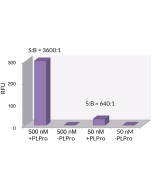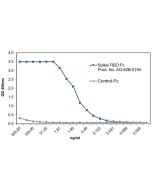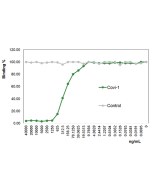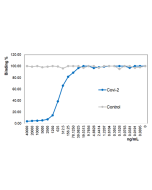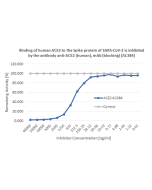Cookie Policy: This site uses cookies to improve your experience. You can find out more about our use of cookies in our Privacy Policy. By continuing to browse this site you agree to our use of cookies.
SouthBayBio
PLpro (SARS Coronavirus) (rec.) (His)

| Product Details | |
|---|---|
| Synonyms | Papain-like Proteinase; SARS Coronavirus Main Proteinase; Non-structural Protein 3; PL2-PRO; Nsp3 |
| Product Type | Protein |
| Properties | |
| Source/Host | E. coli |
| Sequence | PLpro (Papain-like Protease) (aa 1540-1841) (Accession Nr. P0C6U8) is fused at the N-terminus to a His-tag. |
| Crossreactivity | Human |
| Application | PLpro is able to hydrolyze both ISG15-Rhodamine 110 or di-ubiquitin/tetra-ubiquitin substrates, but is very inefficient when processing mono-Ub conjugates or synthetic peptide substrates. Typical working concentration range is 1-10nM. |
| MW | ~37kDa |
| Purity | ≥95% (SDS-PAGE) |
| Concentration | Lot dependent. |
| Accession Number | P0C6U8 |
| Formulation | Liquid. In 50mM HEPES pH 7.5, 100mM sodium chloride, 1mM TCEP. |
| Other Product Data |
Click here for a Typical Lot-specific Product Datasheet from the Original Manufacturer Our product description may differ slightly from the original manufacturers product datasheet. |
| Declaration | Manufactured by South Bay Bio. |
| Shipping and Handling | |
| Shipping | DRY ICE |
| Short Term Storage | -80°C |
| Long Term Storage | -80°C |
| Handling Advice | Aliquot to avoid freeze/thaw cycles. |
| Use/Stability | Stable for at least 1 year after receipt when stored at -80°C. |
| Documents | |
| Product Specification Sheet | |
| Datasheet |
 Download PDF Download PDF |
The severe acute respiratory syndrome coronavirus papain-like protease (SARS-CoV PLpro) is involved in the processing of the viral polyprotein. Proteolytic processing of the coronavirus replicase poly-protein is essential for generating a functional virus replication complex. PLpro possesses both deubiquitinating or deISGylating activity and can process Lys48 and Lys63 linked polyubiquitin chains (free chains or from cellular substrates). It works in concert together with nsp4 in the assembly of virally-induced cytoplasmic double-membrane vesicles necessary for viral replication. It strongly antagonizes the innate immune induction of type I interferon by blocking the phosphorylation, dimerization and therefore the nuclear translocation of host IRF3. In addition, it prevents also host NF-κ-B signaling.






